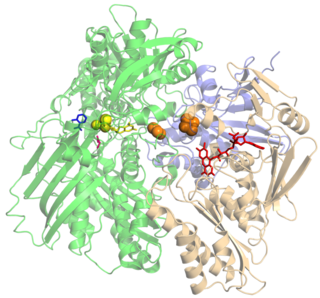
Uric acid is a heterocyclic compound of carbon, nitrogen, oxygen, and hydrogen with the formula C5H4N4O3. It forms ions and salts known as urates and acid urates, such as ammonium acid urate. Uric acid is a product of the metabolic breakdown of purine nucleotides, and it is a normal component of urine. High blood concentrations of uric acid can lead to gout and are associated with other medical conditions, including diabetes and the formation of ammonium acid urate kidney stones.

Gout is a form of inflammatory arthritis characterized by recurrent attacks of a red, tender, hot and swollen joint, caused by the deposition of needle-like crystals of uric acid known as monosodium urate crystals. Pain typically comes on rapidly, reaching maximal intensity in less than 12 hours. The joint at the base of the big toe is affected (Podagra) in about half of cases. It may also result in tophi, kidney stones, or kidney damage.

Xanthine oxidase is a form of xanthine oxidoreductase, a type of enzyme that generates reactive oxygen species. These enzymes catalyze the oxidation of hypoxanthine to xanthine and can further catalyze the oxidation of xanthine to uric acid. These enzymes play an important role in the catabolism of purines in some species, including humans.

Allopurinol is a medication used to decrease high blood uric acid levels. It is specifically used to prevent gout, prevent specific types of kidney stones and for the high uric acid levels that can occur with chemotherapy. It is taken by mouth or injected into a vein.

Hyperuricaemia or hyperuricemia is an abnormally high level of uric acid in the blood. In the pH conditions of body fluid, uric acid exists largely as urate, the ion form. Serum uric acid concentrations greater than 6 mg/dL for females, 7 mg/dL for men, and 5.5 mg/dL for youth are defined as hyperuricemia. The amount of urate in the body depends on the balance between the amount of purines eaten in food, the amount of urate synthesised within the body, and the amount of urate that is excreted in urine or through the gastrointestinal tract. Hyperuricemia may be the result of increased production of uric acid, decreased excretion of uric acid, or both increased production and reduced excretion.

The enzyme urate oxidase (UO), uricase or factor-independent urate hydroxylase, absent in humans, catalyzes the oxidation of uric acid to 5-hydroxyisourate:

Rasburicase is a medication that helps to clear uric acid from the blood. It is a recombinant version of urate oxidase, an enzyme that metabolizes uric acid to allantoin. Urate oxidase is known to be present in many mammals but does not naturally occur in humans. Rasburicase is produced by a genetically modified Saccharomyces cerevisiae strain. The complementary DNA (cDNA) coding for rasburicase was cloned from a strain of Aspergillus flavus.
NADPH oxidase is a membrane-bound enzyme complex that faces the extracellular space. It can be found in the plasma membrane as well as in the membranes of phagosomes used by neutrophil white blood cells to engulf microorganisms. Human isoforms of the catalytic component of the complex include NOX1, NOX2, NOX3, NOX4, NOX5, DUOX1, and DUOX2.

Hypouricemia or hypouricaemia is a level of uric acid in blood serum that is below normal. In humans, the normal range of this blood component has a lower threshold set variously in the range of 2 mg/dL to 4 mg/dL, while the upper threshold is 530 μmol/L (6 mg/dL) for women and 619 μmol/L (7 mg/dL) for men. Hypouricemia usually is benign and sometimes is a sign of a medical condition.

Diamine oxidase (DAO), also known "amine oxidase, copper-containing, 1" (AOC1), formerly called histaminase, is an enzyme involved in the metabolism, oxidation, and inactivation of histamine and other polyamines such as putrescine or spermidine in animals. It belongs to the amine oxidase (copper-containing) (AOC) family of amine oxidase enzymes. In humans, DAO it is encoded by AOC1 gene.

Xanthine dehydrogenase, also known as XDH, is a protein that, in humans, is encoded by the XDH gene.

Solute carrier family 22, member 12, also known as SLC22A12 and URAT1, is a protein which in humans is encoded by the SLC22A12 gene.

Kavain is the main kavalactone found mostly in the roots of the kava plant.
The aldehyde oxidase and xanthine dehydrogenase, a/b hammerhead domain is an evolutionary conserved protein domain.

Solute carrier family 17, member 3 is a protein that in humans is encoded by the SLC17A3 gene.
In molecular biology 2-oxo-4-hydroxy-4-carboxy-5-ureidoimidazoline decarboxylase EC 4.1.1.n1 is an enzyme involved in purine catabolism. It catalyses the decarboxylation of 2-oxo-4-hydroxy-4-carboxy-5-ureidoimidazoline (OHCU) into S(+)-allantoin. It is the third step of the conversion of uric acid to allantoin. Step one is catalysed by urate oxidase and step two is catalysed by hydroxyisourate hydrolase.
FAD-dependent urate hydroxylase is an enzyme with systematic name urate,NADH:oxygen oxidoreductase . A non-homologous isofunctional enzyme (NISE) to HpxO was found, and named HpyO. HpyO was determined to be a typical Michaelian enzyme. These FAD-dependent urate hydroxylases are flavoproteins.

Topiroxostat is a drug for the treatment of gout and hyperuricemia. It was approved for use in Japan in June 2013.

Deoxyribonuclease 2 beta is a protein that in humans is encoded by the DNASE2B gene.
















